by Leslie Weaver, Faculty Consultant, University Writing Center
Most of the cases of plagiarism we see in the writing center are unintentional—students are not trying to cheat; they just do not understand the mysterious, and seemingly inexplicable, rules of documentation. What exactly should be cited? How is an online source handled? To add to the confusion, students must decide which documentation system to use—MLA, APA, Chicago, ASA. No wonder students, coming to the writing center for help with their citations, offer the following words: My professor says if I plagiarize I will fail!
I like to keep in mind the three basic reasons for documentation, also called citing sources. First, I must give credit to the original source. Anytime I borrow specific language from a source or even simply an idea from a source, I must cite the source. Most writers understand that quotation marks and a citation must be used when they copy a source’s material word-for-word (a direct quote). But what does it mean to “borrow an idea?” If I paraphrase an idea from a source–put the idea I read about into my own words and use my own sentence structure–I still have to tell my readers where I got the idea. Every idea that is not my own should be clearly marked. A citation gives credit to the original source.
Second, we document because we want to look credible to our readers. If I use a statistic about the prevalence of cancer among urban areas, my readers will be more likely to believe my statistic if I show a reliable source for that material. (Something like the American Cancer Society.) That is, if I use smart and savvy sources, I, too, will appear smart and savvy. This is why students are often told to avoid Wikipedia as a source. While Wikipedia can provide me with some basic information on an unfamiliar topic, it is not a smart or savvy source for an academic paper.
Finally, we cite our sources to leave a trail for the readers. If you read something interesting in my paper, you should be able to follow a trail to find out more information on that topic from the same source. Perhaps you want to know more about that cancer rate in urban areas. First you look at the citation that follows the statistic. The source listed there should appear in my list of references at the end of the paper. From the information listed there, you should easily be able to find the same material for yourself. If you cannot find the material easily, I have not done my job.
Just remember that we document sources for these reasons: to give credit, to appear credible, to leave a trail. Following these three guidelines should allow students to avoid unintentional plagiarism.

